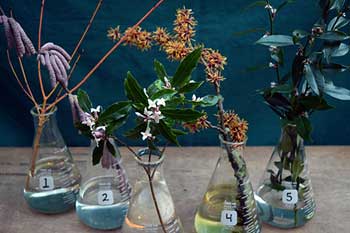January Color Brings in the New Year at the Washington Park Arboretum

Witt Winter Garden
1) Cornus sanguinea ‘Midwinter Fire’
Midwinter Fire Dogwood
- Though the species normally has red twigs and purple fall color, this outstanding cultivar has golden-yellow fall color followed by red-blushed, yellow twigs.
- This dogwood is native to northern Europe into northwestern Asia.
- Full sun is required to obtain the best winter stem color and this dogwood will slowly colonize an area via suckers from its shallow roots unless controlled.
2) Corylus maxima ‘Atropurpurea Superba’ Purple Giant Filbert
- This excellent selection of the Giant Filbert produces long purple catkins in winter followed by large purple-red leaves in spring.
- From what we have observed in the Witt Winter Garden, this specimen is resistant to eastern filbert twig blight, caused by the fungus Anisogramma anomala.
3) Daphne bholua ‘Jacqueline Postill’ Lokta, Paper Daphne
- The specific epithet “bholua” comes from “bhulu swa”, the Nepalese name for the species.
- Despite having a native range to 12,000 feet in the Himalayas, this species of Daphne is just as hardy in Seattle and requires a protected placement in the garden.
4) Hamamelis x intermedia ‘Winter Beauty’ Winter Beauty Witch Hazel
- The north end of the Witt Winter Garden contains many species and cultivars of witch hazel.
- Witch hazel flowers range from sulfur-yellow to carmine-red, while their fragrance can be absent, lightly floral or an intense citrus.
5) Sarcococca hookeriana var. digyna Sweet Box
- Sweet box is an often overlooked element of the Witt Winter Garden due to the diminutive size of its flowers, though no one can miss their intense fragrance.
- Perfectly comfortable in dry shade, Sweet Box is an excellent choice for under-planting taller shrubs or small trees such as Hamamelis.